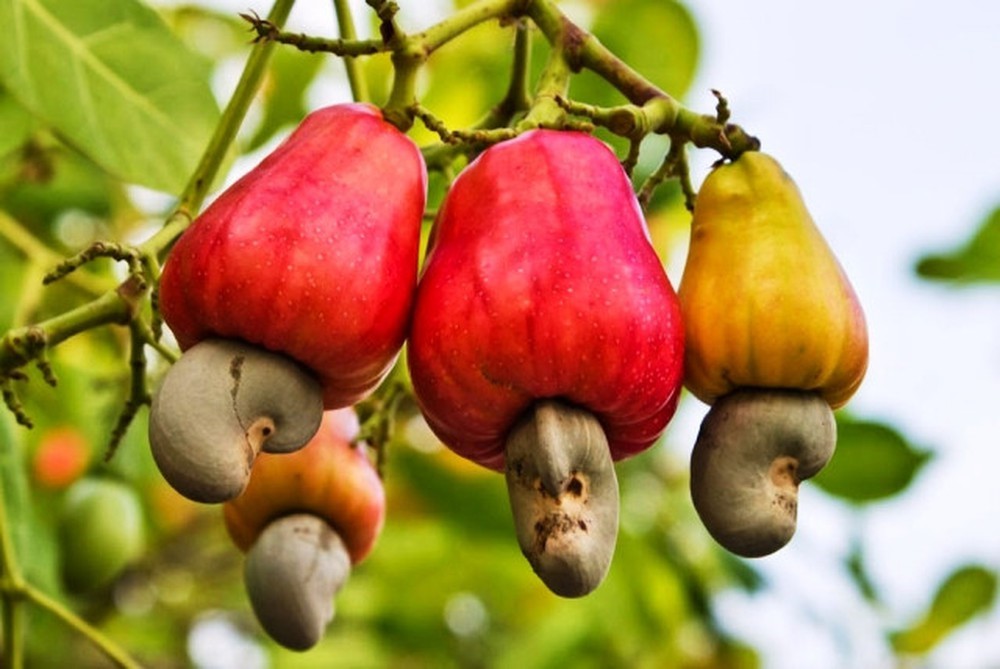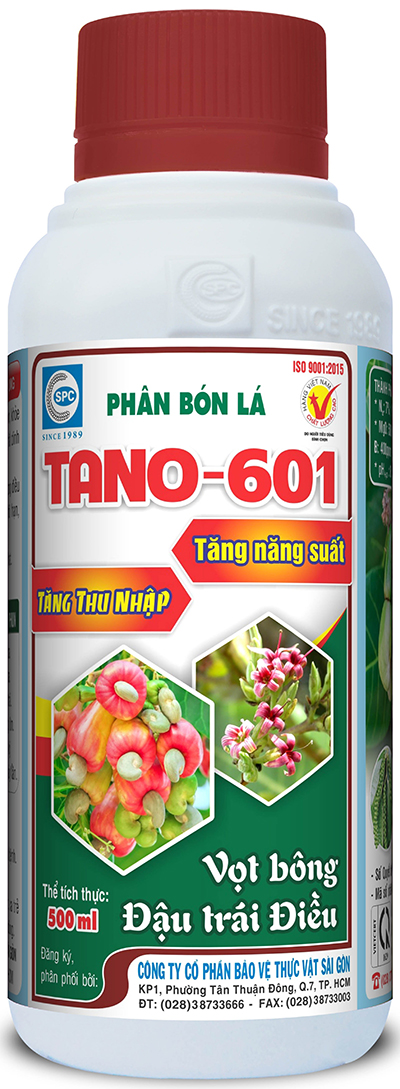|
Tano 601 foliar fertilizer application during cashew nut season in blooming-fruiting
17/12/2021
BSc Do Cong Hoang From October to December of the solar calendar every year, cashew orchards in the Eastern Central Highlands and South Central provinces gradually shed their old leaves and put on new, green foliage. At this time, the bird tree also begins to bloom and bear fruit, and needs more nutrients than usual. In order to get high yield and good quality of cashew nuts, in addition to fertilizing the base on an annual basis, gardeners need to pay attention to supplement foliar nutrients by spraying a combination of foliar fertilizers with other pesticide to save costs. This article is intended to introduce to gardeners a fertilizer product for cashew with complete and balanced nutritional composition of Saigon Plant Protection Joint Stock Company, TANO 601 foliar liquid fertilizer, which is used to help Plants grow in harmony, bringing bountiful effects to cashew growers during the blooming and fruiting season. INGREDIENTS: Ntotal – P2O5 effective – K2O effective: 7% - 6% - 7% MgO: 0.05%; Fe: 400ppm; Zn: 400ppm; Mn: 500ppm; Cu: 200ppm; B: 400ppm. Humic Acid: 0.3% Ph H2O: 8 Density: 1.3 USES: Helps cashew trees grow fast and strong by enhancing the ability to absorb nutrients in the soil and strong photosynthesis. Balanced nutrition, helps to increase resistance in adverse environmental conditions such as alum, salinity, drought, hoarfrost, etc. Fast growing tree, early blooming, increased fruit setting rate, strong seed production. USER MANUAL: Mix 30 - 40ml of TANO 601/16- liter-watertank, or 380 - 500ml/drum of 200 liters of water. Spray at the following times: About to bloom, after blooming, after fruit setting and when the fruit is growing, spray every 10-15 days. NOTE: Shake well before using. Spray evenly wet the canopy in the early morning or cool late afternoon. Can be mixed with pesticides
|
To prevent, in addition to plowing and burying weed seeds, collecting weed stalks and stumps left after tilling the land to burn, not letting weeds produce seeds in production fields, etc., the use of chemical products is still a measure. optimal because of its ability to thoroughly kill weeds, reduce labor and take advantage of more time than manual weeding.
Miner has the scientific name Phyllocnistis citrella Staint., family Phyllocnistidae, order Lepidoptera. The miner occurs in many countries in the tropics and subtropics. The main host of the miner is the citrus family - Rutaceae. In addition, the miner also attacks mangosteen and some other plants.
Adult is a small planthopper, with a body 2-3 mm long, the whole body is ash gray, slightly greenish, the wings are opaque with many small brown spots.Eggs are oval, 0.3 mm long, have a pointed end and are attached directly to the leaf surface, leaf axils.
Green bugs specialize in the fruit of citrus groups (oranges, tangerines, lemons, grapefruits, kumquats...), some people call them orange bugs, or orange suckers. Their scientific name is Rhynchocoris poseidon or Rhynchocoris humeralis.
In Vietnam, yellow leaf curl disease is very common on papaya trees, especially the disease is often severe in areas of high and continuous planting, areas with hot and arid climates. The disease has significantly reduced the yield and quality of papaya. Gardens that are infected early when the plants are young may not yield. However, up to now, many gardeners still do not know the cause and how to fix it.
Spider mites are common pests on citrus trees, especially in hot and dry climates that are suitable for spiders to grow and cause severe damage.The group of harmful spiders is usually very small in size, unlike the natural enemy spiders.
This group includes species that are generally very small in size, causing damage by sucking plant sap (on leaves, fruits, branches, stems).
There are many species of mealybugs present on the group of Oranges,Tangerines,Grapefruits and Lemons (Citrus), which can be divided into 2 groups:
+ Group of sticky mealybugs with common varieties such as Lepidosaphes, Aonidiella, Coccus and Saissetia.
+ Group of flower mealybugs with common genera and species such as Pseudococcus, Planococcus and Icerya purchasi.
Dry branches and berries disease often appear to be common damage on coffee gardens during the rainy season. The disease causes death of branchs, dry fruit, severely affects the canopy structure and coffee yield if not paid attention to prevention.
Pink disease commonly causes diseases on rubber plantations in the rainy season, especially on garden from 4-8 years old. This year, rubber has to go through a period of severe drought, weakening the tree, so now in tnshe rainy season it is easy to get infected. Therefore, it is necessary to pay attention to good management to avoid affecting the garden.
In recent years, the area of citrus has been expanded because it is a fruit tree with high economic efficiency. However, in order to sell at a high price, not only in quality but consumers also require the external beauty of the fruit, so pest management on citrus is a matter of great concern to farmers. The hot season is a favorable condition for thrips to develop and cause damage, affecting the commercial value of fruit.
- Headquarters
- SAIGON PLANT PROTECTION JOINT STOCK COMPANY
- RQ 1, Nguyen Van Quy St., Tan Thuan Ward, HCM City
- Tax code: 0300632232
- Tel: (028) 38 733 295 - 38 732 077
- Fax: (028) 38 733 003 - 38 733 391
- Website: www.spchcmc.vn - Email: info@spchcmc.vn
- SAIGON PLANT PROTECTION COMPANY
- SAIGON PLANT PROTECTION JOINT STOCK ENTERPRISE
- Lot C1-C3 Hiep Phuoc Industrial Park, Hiep Phuoc Commune, HCM City
- Tel: (028) 3873 4089 - Fax: (028) 3873 4086
- Affiliated Unit
-
- Quick Links
- Home
- About us
- Career Opportunities













